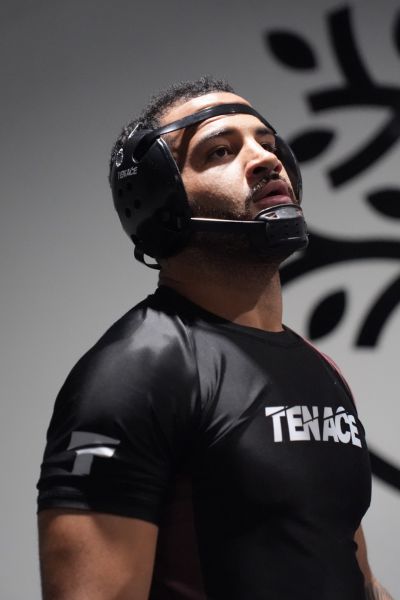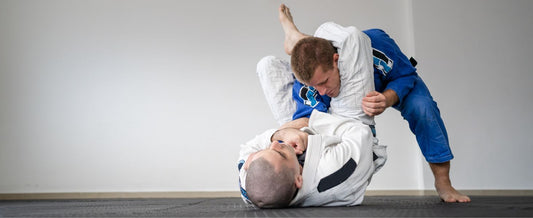Blog Index
- Why training with higher belts can accelerate your evolution?
- The role of the highest belt: guidance, challenge, and responsibility
- What should the lower belt look for in these workouts?
- Common mistakes beginners make when riding with advanced riders
- How to get the most out of sparring with someone better than you?
- What if you're always getting crushed? What you're also learning
- The importance of mutual respect on the tatami
- Tips for High Belters: How to Help Newbies Progress Without Frustrating Them
- Together we evolve faster
1. Why can training with higher belts accelerate your evolution?
Higher belts can be a blessing… or a nightmare. They easily trap you, seem to read your moves before you make them, and often make you feel like you know absolutely nothing.
But what many don't see, and what is very important to keep in mind, is that training with someone more advanced can be the fastest and most powerful way to improve .
Why? Because when you ride with someone who's two, three, or even more degrees above you, you're stepping out of your comfort zone, and that's what will make you evolve.
You are exposed to mistakes you didn't know you were making.
When you ride only with people at your same level, it's easy to enter a kind of "technical comfort zone." You make mistakes, but you're not punished as much. You repeat mistakes, but you don't always pay dearly for them.
With a higher belt, sometimes there's no forgiveness. That misplaced grip, you get punished, that half-assed transition, you get over your guard. But this forces you to correct small details that will make a big difference in your game.
Exposes you to more advanced strategies and timing
It's not just about technique. Filming with someone more experienced is like watching a chess game with someone who's five moves ahead.
You begin to notice how they control the pace , how they provoke you into making mistakes, how they close down opportunities before you even see them. And even if you don't understand anything at first, your body absorbs that tactical wisdom without you even realizing it.
You learn to stay calm under real pressure
A key part of combat, one that's often under-trained, is emotional management. That's when you're being crushed, when you can't breathe properly, and when you don't know how to get out of a position.
Training with higher belts puts you in that constant discomfort… but it also trains you not to panic , to look for solutions in the chaos, and to develop what many call the “fighter’s mind.”
The learning curve accelerates
Do you know why some wrestlers progress in half the time of others? Because they're not afraid to roll with better people .
Even if you miss every sparring session at first, the learning hidden in every minute of those workouts is pure gold. It's as if, instead of studying for an hour on your own, you were having a debate with an expert: you'll absorb more, even if you don't understand everything.
It's not a punishment, it's an opportunity
Many people avoid riding with higher belts out of pride or fear of ridicule. But the correct mindset is just the opposite:
“Every time I ride with someone better, I’m training myself in fast motion.”
So the next time a brown, purple, or black belt says, “Shall we roll?” don’t take it as a sentence… but as a free private lesson.

Tenace Blue BJJ Belt - Adults
2. The role of the highest belt
In every academy, the highest-ranking officers are key figures. Not only for their technical expertise, but also for representing a blend of mentor, combat partner, and role model.
When a less advanced fighter rolls with a higher belt, they shouldn't feel like they're in an "uneven match." In fact, the best fighters don't use their level to crush, but rather to guide, push, and teach without saying a single word .
He is a guide, a silent teacher
Advanced belts know when to let you work and when to push you. Often, without saying anything, they're teaching you to move better with their energy, rhythm, and control alone.
A good higher belt will:
- It allows you to get into certain positions so you learn how to react.
- He doesn't abuse his superiority, but he doesn't give you anything for free either.
- Correct errors in real time with subtle pressure, transitions, or escapes.
That's pedagogy in action. And it happens on the roll, without the need for words.
It's a challenge, the obstacle you need
One of the greatest gifts a higher belt can give you is not letting yourself be beaten easily. In a world of quick likes and praise, it's easy to confuse "progress" with "I'm letting you look good."
But a true partner isn't there to inflate your ego, but to hone your skills.
- Do they repeatedly pass you by? They're teaching you how to strengthen it.
- Are you being held in lateral control? Are you learning how to breathe under pressure?
- Are you strangled and don't even know how you got there? Welcome to real learning.
Every sparring with a higher belt is an accelerated Jiu Jitsu/Grappling class , if you know how to observe and not just survive.
They have a responsibility, that of teaching without imposing
The role of the highest belt also implies maturity. Not everyone possesses it, but those who do make a difference in an academy. They know how to adapt intensity, recognizing when you're ready for a challenge and when you need to learn without stress. They avoid using unnecessary strength or speed with less experienced practitioners.
A good high-ranking belt isn't there to "beat" you, but to help you become a better person. But it will also require you to stay focused, to think, and to strive to improve every minute.
3. What should the lower belt look for in these workouts?
When you're a white, blue, or even purple belt, training with someone more advanced can be intimidating. But here's what to look for when training with a higher belt , so you can make the most of every minute.
What you need is not strength, but curiosity, humility and perseverance.
Many lower-skilled belt holders become frustrated by being constantly monitored. But that poorly managed frustration is a hindrance. Those who transform it into questions and analysis evolve threefold.
* Seek clarity, not victories
The first thing to get out of your head is the idea of “winning” the fight.
A higher belt beats you based on technique, experience, and pace. But you can "win" if you come away from the fight knowing more than you did before .
✅ Where did you fail?
✅ Which control surprised you?
✅ What could you have done differently?
* Notice
There are details that a lower belt rarely trains: timing, energy management, exact weight placement...
A higher belt doesn't just subdue you: it teaches you without speaking , if you look closely.
- When it moves and when it waits.
- How he positions his body to not give you space.
- What you do before entering a submission.
- How he stays calm even under pressure.
You don't see that kind of thing in videos . You feel it, you learn it on the mat.
* Try new things (and fail on purpose)
If you already know it's very difficult for you to "win" that fight, then you're free to experiment. Try a new stance, an escape you haven't mastered yet, a transition you're hesitant about.
Do it with the advanced ones. They have the control necessary to make you fail without paying the price of injury . They understand that you're just trying, not doing something crazy. Train to improve, not to survive. The high belt can punish you... or it can help you. The difference is in how you move and what your intention is.
* Learn to give up in time
A fundamental part of training with higher belts is developing confidence in the environment . Knowing that you can tap without fear, that you can make mistakes without judgment, and that learning is in the process, not just in the submission.
Many low belts hold on too long, out of pride or fear. But that only delays learning (or, worse, causes unnecessary injuries).
Learn to give up in time. You're not losing: you're understanding where the limit is.
After the fight, don't just walk away as if nothing happened. Take a few seconds to ask yourself this question:
- What was the moment when I was most uncomfortable?
- What did he/she do that I didn't understand?
- How can I avoid getting stuck in that position again?
Rashguard BJJ Competition Tenace
4. 5 Common Mistakes and How to Avoid Them
Riding with someone of a higher level is a tremendous opportunity to grow... but it's also easy to make mistakes that limit your progress (and sometimes make your partner uncomfortable). Here we review the most common ones and, most importantly, how to avoid them .
1. Roll like it's a World Cup final
Many students, especially new or competitive ones, try to "test" themselves against a higher belt. They give it 110% from the first second. The result:
- You get exhausted in 30 seconds.
- You don't see anything of what the other does.
- You end up frustrated (or injured).
What to do? Adjust your intensity to the highest level of speed. Remember: if he wants to, he'll subdue you in 10 seconds. But if you maintain your composure, you can learn a lot more.
2. Do not propose anything (just defend)
It's a classic. They catch you in an awkward position and you spend the entire fight holding on, waiting for it to end.
The problem is that passive defense doesn't teach you how to escape or attack . It only teaches you how to resist. And that, on the street or in competition, isn't enough.
What to do? Even if you know your attempt is going to fail... do it.
Propose, attack, move = mistakes → correction → learning.
Waiting = stagnation.
3. Don't ask questions later
Many lower-skilled belt users believe that bothering advanced belt users is frowned upon. But the reality is that if you ask respectfully, almost everyone will be happy to help you.
What to do? Ask specific, brief questions and show that you're paying attention.
4. Always repeating the same thing
Many students, out of fear or comfort, play the same old game, without trying anything new. With a more skilled partner, it's the perfect time to step out of your comfort zone.
What to do? Choose a specific area you want to explore: mounted defense, back escapes, a new guard. Riding with a superior guard allows you to test without fear of injury and receive realistic feedback.
5. Silent ego: avoid rolling with the best
“It always destroys me, better with someone of my level.”
This is a mistake that seriously hinders growth. Riding only with equal or more experienced beginners can give you confidence… but at the expense of not improving.
What to do? Make the highest belts a regular part of your week. It's not only normal to be overtaken by: It's the best thing that could happen to you. Every fight with them is a technical leap that would take weeks to achieve on your own.
5. How to get the most out of sparring with someone better than you?
If you train regularly, sooner or later you'll find yourself riding with someone who's clearly superior: more technical, stronger, more experienced. And if that doesn't happen to you... you're probably not in the right place.
Here we give you the keys to getting the most out of sparring with someone better than you, without shattering your ego (or your joints).
Define your goal BEFORE sparring
If you go into the race with the sole intention of "not dying," you've already lost focus. Define a micro-mission. You don't need to "win," but you do need to have a clear intention. That intention keeps you focused and turns every submission into a clue, not a defeat.
Before you start sparring, ask yourself:
- Do I want to work on escapes?
- I want to improve my defensive guard?
- Do I want to survive 2 minutes without being finished?
Slow down, but stay focused
When you're riding with someone better than you, the temptation is to go fast to avoid being caught. But speed leads to mistakes… and unnecessary stress.
Work slowly, precisely and wisely.
Your advanced partner won't exploit you for going slow. On the contrary: if they see you trying to build good technique, they'll probably let you progress further before punishing you.
Ask questions when you're done and try new things.
This point is golden, and almost no one does it. As we mentioned in the previous point, after sparring, don't just get up and go out to drink water as if nothing happened. Stay for 20 seconds longer and ask a clear question. Build with someone better and try new things without fear .
- “What did I do wrong when I tried to escape?”
- “Was there anything I could have done better since the ride?”
- “What did you see when you took my back?”
6. What if you're always getting crushed? What you're also learning.
And yes, we understand. Sometimes training in grappling, BJJ, or wrestling with people who are way above you feels like hitting a wall over and over again. But what you don't realize at the time is that wall is teaching you more than you realize.
Here are some truths that many don't tell you:
You are building defense
They don't subdue you as quickly as they used to.
You last longer in bad positions.
You escape more often (even if it's not perfect technique).
You know when to give up before you get hurt.
All of that is defense. All of that is evolution.
And you don't learn from tutorials or drills. You only learn by riding with people who are better than you .
You are developing instinct
Even if you don't know exactly what to do, your body begins to understand what not to do:
- Don't turn your back so easily
- Do not extend your arm reflexively
- Do not turn in dangerous directions
That instinct is what sometimes saves novice grapplers from injury or quick submissions. And it's trained, without you even realizing it, when you get crushed over and over again.
You are learning to read the game
At first everything goes so fast that you don't see anything.
But little by little, you begin to recognize what's going to happen, or understand what each position is, and when that position will arrive. Even if you don't stop it, even if you don't avoid it, just identifying it is a giant step.
You're building what experts call "game vision." And without it, you'll never be truly good.
You are training the strong mind
Do you know what differentiates those who achieve black belt from those who drop out? Frustration tolerance.
Getting crushed three times a week and returning to the mat with a smile on your face is a mental skill that requires training. It's humility. It's resilience. It's patience. It's part of the journey.
“I learned more from losing 500 sparring matches than from winning 5.”
7. The importance of mutual respect on the tatami
The tatami isn't just a place where you learn techniques. It's a space where people are forged. And without respect, what you're building isn't community: it's ego, rivalry, and chaos.
Respect isn't weakness, it's strength. Respect is understanding that we're all here to grow. That we all have something to teach. And that art is above your ego.
- Don't use your brute force against someone weaker.
- Don't laugh if you easily dominate a partner.
- Don’t “underestimate” the novice who is just starting out.
- Don't hurt to prove something.
- Do not correct by shouting or from ego.
In an art like BJJ or grappling, we are all students. Even the black belt continues to learn every day. Because it's not just about "who wins," it's about how we evolve together.
And that's only possible when you train in a healthy environment, where you can make mistakes without fear, ask questions without shame, and improve without feeling like you're competing with your team.
The respect you practice here, you take with you to your home, work, relationships, and the streets.
8. Tips for High Belters: How to Help Newbies Progress Without Frustrating Them
Reaching a high belt doesn't just mean knowing more technique or having won more fights. It means that, in some way, you've become a reference. And that comes with a new responsibility: helping those who come after you without letting them break down along the way .
Many people quit grappling or BJJ not because they don't like it, but because they feel lost, stuck, or mistreated . And often, that feeling stems from how those who know best treat them.
So, whether you're a blue, purple, brown, or black belt, these tips can make a big difference in your team's progression and permanence.
1. Adapt your intensity
It's not about "letting them win," but about giving them the kind of resistance that makes them grow.
If they're learning a new technique, don't give them 100% resistance on the first try. If they're nervous, don't crush them without giving them air. If they're rolling with you, it's not about proving you're better (they already know that).
2. Be clear when teaching, not confusing to sound intelligent
Avoid abstract explanations or unnecessary technical detours. Remember that newcomers are still adapting to the terminology, the movements, and the pressure.
Use visual examples or simple comparisons. Ask if they understand (and listen carefully). Don't make them feel stupid for not knowing.
3. Listen more than you talk and help them build “small wins.”
A new belt isn't going to subdue you yet. But it can improve your posture, your pressure, your core... and that's already a victory.
Tell them when they're doing something right. Correct them with kindness, not sarcasm. Make them see that progress isn't just about "winning roles," but about improving 1% each week.
4. You also work
A simple "Do you need help with that technique?" or "Do you want to go over it after class?" can change someone's day. The high-scoring belts who have the greatest impact on their team aren't the strongest. They're the most generous.
Riding with beginners isn't a "waste of time." It's your opportunity to:
- Polish your control.
- Work without force.
- Try new transitions.
- Develop your role as a technical and emotional leader on the tatami.
Your trophies inspire, yes.
But what the lower-slung people will remember most about you won't be your invincible guard, but how you treated them when they knew nothing.
9. Together we evolve faster
On the mat, we are all on different paths, but moving in the same direction .
The white belt who is frustrated today because he can't escape the mount will tomorrow be helping a newer one.
The brown belt who patiently leads today was once the one who left class confused, with swollen ears and doubts hanging over his neck.
And in that cycle—of learning, sharing, and growing together—is where true evolution is born.
You can watch thousands of videos, do drills at home, or sign up for seminars. All of that helps. But nothing replaces the impact of training with teammates who challenge you, care for you, and teach you .
And that's why the best team isn't the one that wins the most, but the one that lifts each other up the most.
Each one has its role, but all are equally valuable.
When we truly understand that, progress accelerates. Because you're not training against your teammates. You're training thanks to them.
Protect your team, protect your body
Evolving together also means taking care of each other. Because there's no progress if there are injuries, and there's no team if one breaks down.
So, whether you're just starting out or have been riding for years, using the right gear isn't optional: it's respect.
At Tenace, we've created a selection of protections designed for you and your team:
✅ Earmuffs that save you from cauliflower without sacrificing comfort
✅ Lightweight knee pads, perfect for pain-free shifts
✅ Elbow pads for those who play with pressure and control from above
See all protections here
( Click and train stronger, safer, and longer. )






